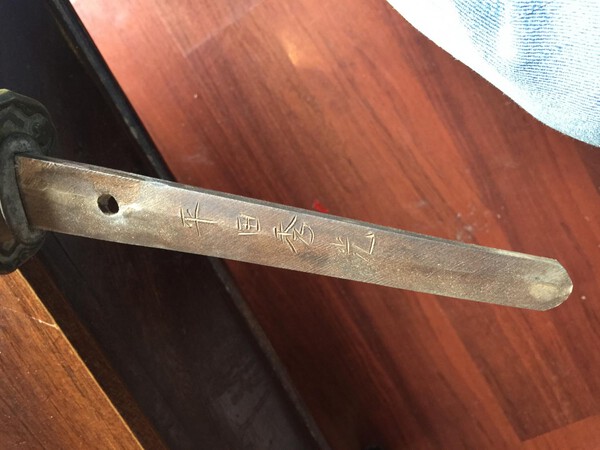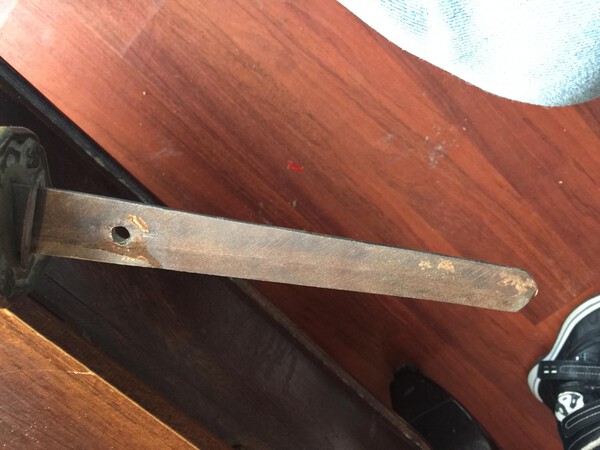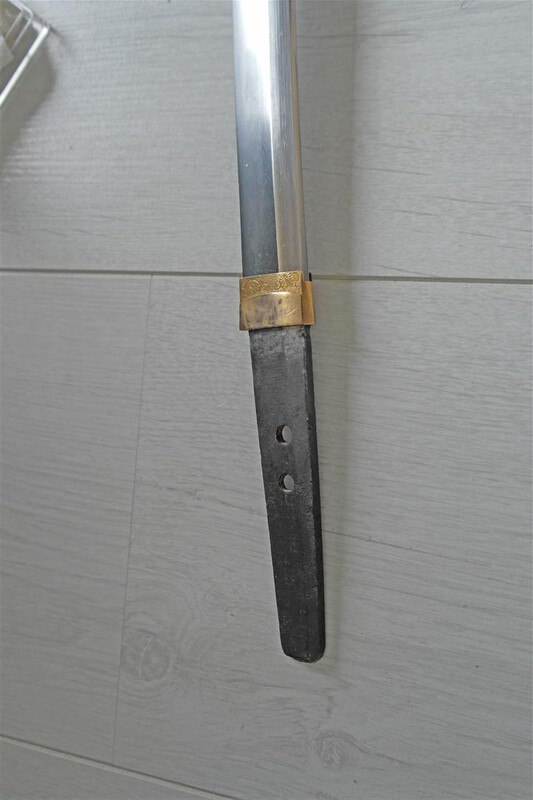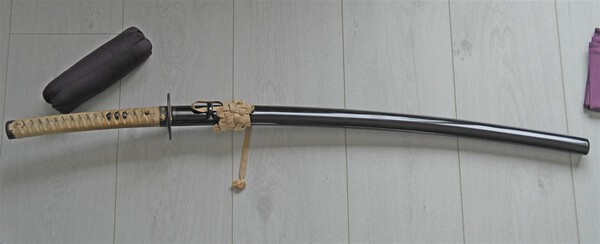-
Posts
35 -
Joined
-
Last visited
Content Type
Profiles
Forums
Events
Store
Downloads
Gallery
Everything posted by Klaver
-
-
I recently hold this blade, can anyone help with mei translation? Any other information anyone could give would also be appreciated. I not at home so do not have any book availabe. much thanks! I think its gendai gunto.
-
okay many thanks, I overlooked this character. I am always aware of gimei as far as I can construe this. I see you have a lot of generations sukemitsu smiths. But I found another piece which the mei looks very different and more faded or old. What are your thoughts about this?
-
Hi all, This is a second piece my friend showed me. The nakago includes a mei, those are two characters so means its the Smith name. I am pretty sure about the First 助 Suke cannot find in my books the second. This one is a wakizashi, it has masame hada and gunome hamon in nie with some chikei if I am right. It has no tsuba, but koshirae is nice and is Ubu. The polish is not to great also but for and old piece its okay, you can also see the strike and the Ha and Mune has some scratches. Not papered also, what do you think??
-
Hi all, A new friend of mine brought over some of his treasures which he owns already for many years. However he does not know anything about those swords and objects besides the facts the likes them. I am trying to tell him some more and here are the things I am pretty sure about. Its a masame itame hada, the blade is mumei unforturnately and not papered, because of this I think about Soshu school (hada). Its a gunome hamon and I think sunagashi, the blade itself has some sunagashi elements I think. Its very active with the right light. The polish is not to great and I also discovered some small litlle cracks running lenthwise which indicates the swordsmiths skills, I think. Many thanks already.
-
I think there is not “one” way to see if a signature is Gimei. The reason for this thread here is what you semi professionals think. Haha, yes of course only shinsa can give a direction, I do not think they are always 100%. Gimei is something always was happening from time to time for reason we cannot imagine probably. First the (gi)mei looks rather rough and uneven. Also Settsu no Kami means younger brother of the 1st gen I think, but you also have 2 generations or even three. Anyway, smith falls under Tadatsuna school which has a lot of choji midare, but this blade does not appears to have this. So my guess it Gimei but are curious about others minds to more or less. If not appreciate by others sorry for posting.
-
Hello, what do you think? Is this one Gimei? Will it pass shinsa? Signature seems: Settsu Kami Tadayuki
-
Thanks, ok, I found this katana, I unfortunately cannot read anything they wrote. http://page6.auctions.yahoo.co.jp/jp/au ... enlargeimg Suguata seems Shobu Zukuri with Ubu Nakago. Period Kanbun April 1661 to September 1673, a so called Shinto Katana. I has little sori which was common in this time. It seems narrow hamon, I thought it was more wider at that time, but narrow hamon has advantante you have more soft steel so has a better shock resistance. Can anyone read the papers included?
-
Marius, thank you for your reply. And yes, Ken, I was also playing with those questions you mentioned. I do not have an agent either, how can I find one? And even if you have one, how do you get an idea about a "market" uniform price. Also the thought I was playing with, how a decent seller like AOI are getting thier pieces, they have an huge refreshing amount.
-
Hi Guys, This katana took my attention. It is signed with Kikuhira. Correct me when I am wrong but this smith was working at Hizen province, probably Kanbun era. What do you think about this katana? I know the worth of a katana is how much you personally admire the piece, but I think this one is very well priced. Is is pity you cannot see the blade very well with close ups to look after flaws. http://www.ebay.com/itm/Authentic-Japan ... 9007wt_923
-
Hi, maybe here you can find some tsukamaki restoration services: http://japaneseswordindex.com/sites2.htm
-
What do you think of those: Fred Lohman - http://www.Japanese-swords.com/ Aron Justice - http://www.ronin-outpost.com/ronin_outp ... amaki.html
-
I like this naginata very much, it is papered and the polish seems ok. Do you know if the “shirasaya” is the same age? I like the rattan details on it. It normally also has a habaki. For what I know the naginata was a real sophisticated weapon and requires a lot of skill to used it effectively, I have done some workshops with the training naginata’s. You have different theories how this weapon was evolved. Enjoy your new naginata.
-
Hey, do you think those papers are genuine? http://www.huanuosword.com/?product-372.html I am missing a stamp on the nakago picture?
-
Hello, I want to know what the aspects are of a “tired”blade. Not talking about flaws. The first aspect I would note is a small hamachi, but this is difficult one also, you can have a blade with a small hamachi but with an excellent polish the small hamachi is also not an issue, I think. Second are general dimensions due to overpolishing. Very small sakihaba, sakikasana, motohaba, motokasana, small Ha. Third is suguta: blades can be wider at the hamachi compared to rest to avoid removing the hamachi. Fourth: the Ji consitst of softer steel so the overpolishing maybe more visible at this area. The Nakago area may have the original dimensions, do you think you can feel a difference between those original dimensions and the overpolished part? I have not seen much of them. What else do you think about with judging a tired blade? Thanks already for your feedback.
-
Geraint, Your points of view are really making sense. I do think a papered katana can also be o-suriage, if I understand you well. You have one hole so this does not indicate surriage. The shape seems right also. I thought because of the re-shaping some Mei has got lost due to those techniques. I remember I have seen an o suriage blade and they forged in the old Mei, but this was clearly visible in the steel pattern. I think your thought this nakago is re worked to fit specific koshirae makes the best explanation for me.
-
When I see this I would think O-suriage, but in this case I think AOI will mention it in the description, but they have not. The oxidation has the same pattern, you can see some file marks on the none Mei side I think, they want to get rid off the full mei?
-
Thank for the prompt reactions. Ok, so here I go, does anyone have in the same price range a katana with papers so I can take a look, if I like it? If you have you can PM me if you want. I do not like to flashy katana's. I think the reactions from AOI are very vague, he probably does not know it also. I like this one also: http://www.aoijapan.com/katana-musashi- ... aru-sekido The hamon is more active, but this one does not have koshirae what gives me an extra added value. I understand I must go for the nagasa but those things are something you are sometimes split in betweeen. What do you all think about this one?
-
Yep, you are right, but you can also read: Shape : It is wide and thick and magnificent looking katana > of course this does not say anything about the condition. I personnaly think this can be the bottle neck: Special feature : Enjyu Ieyoshi is known to be the last generation of Enju school. However, it is not written on the directory so it is assumed that he was helping the wordsmith for most of his life. The blade condition seems not to bad, what all do you think about the condition?
-
Hello, thanks for the feedback! I asked Mr Kazushige Tsuruta, this is what he told me. I think the blade will pass NBTHK Hozon token. The NBTHK is strict. So we cannot guarantee. Do you think the Shinsa want to find out more if they cannot constue it directly? The fact is I like the blade and koshirae. The hiro-suguha is attrative and the itame hada looks very fine. I need to see the sword activities with my own eyes, difficult for me to see it from pictures, for me right now, from pics you get an idea but the reality is sometimes different with those katana's. Personally I do not care if a smith is high graded, sometimes a blade just makes my heart goes faster, do not know why. Of course I want to know the theory behind all this and mostly I do recognise the high rank smith only my wallet does not like it to much. I think the nioi is pretty nice at the hamon. What do you think of the spot at the shinogi near the mitsukado and ko shinogi down at the yokote line? I think it is a kurijri tang with a straight file mark. What do you all think about the Signature: Enju Ieyoshi? Thank for you support already!
-
Hello, I would very appreciate your opinions. Do you think this katana will pass the Shinsa? I think the Mei is correct. Signature: Enju Ieyoshi Manei 2 nenn 2 gatsu hi The blade is still be aesthetically worthy despite the fact it has scratches. As far as I know the jidada is not repaired. No chips in the blade. Era : Late Edo Period Shape : It is wide and thick and magnificent looking katana Jitetsu : Itame had well grained with jinie. The texture of the ha is dymanic. Hamon : Nie base suguha with koashi attached. Boushi is hakikake(brush up) style. Special feature : Enjyu Ieyoshi is known to be the last generation of Enju school. However, it is not written on the directory so it is assumed that he was helping the wordsmith for most of his life. Historical background: Manei first year(1860), on Sakurada Mongai Incident, Mito domain and satsuma domain datsuhanroushi(Those who left the domain by their own will) have attacked the line of HIkone domain and have killed the daimyo federal lord of Bakumatsu, Ii Naosuke in Sakurada gate of Edo castle(it is now the front gate of metropolitan police department). In the police department, there are the remaining of the nihonto that was used in the battle and the polisher I have known for a while has been asked to polish one of the blade 20 years ago. However, the katana had been cracked in half with many hakobore(minor cracks).
-
Brian, Yep you are right, discussed a lot, I am sorry, Anyway, a new way of working for me. "I use alcohol or acetone to remove dried oil. It evaporates and leaves no residue. It doesn't scratch the blade. I use a microfiber cloth to wipe the alcohol/acetone/dried oil. The fibers create a suction that lifts residue off the blade without scratching. I use a water displacing oil like Sheath. Newly polished blades are wiped wiped with the microfiber cloth once a week for a period of 3 months or so and reoiled. I use a cotton/flannel patch about 2 inches square to apply the oil.". I already was aware Choji Oil is a mineral oil , but I found it kinda strange AOI shop does not recommend the mineral (choji) oil but a CLP basicly.
-
Hey There, I was looking at the Aoi Art webshop and at the treatment page I found this: Special notes 1. Generally, Chyoji oil has been used to treat Japanese swords. This is a sticky vegetable oil traditionally used in cleaning swords. It promotes ozidization of the blade that will result in rust in the future. In our opinion, and based on our experience. We not advise you to use chyoji oil. We suggest that you use high-quality machine oil on your sword. This is the same type used when maintaining guns or sewing machines, and it is the only oil that we use with our swords at Aoi Art. I am a vendor in high-end chinese Japanese styled swords and to be honest sometimes I use the hanwei oil spray, which basicly is a CLP oil to clean and protect the katana's I have in stock. In my little workshop I always use Choji Oil and I never had a problem with both. Before shipment I check the katana's personally, and at those moments I use Choji Oil mostly, when I want to see the blade clearly. Just keeping them in Oil is doing fine in my opinion. The nihonto's I have in my personal collection I always use Choji Oil, which gives me a good feeling from a tradionional point of view. I was just wondering what you all use for your Nihonto's.






















